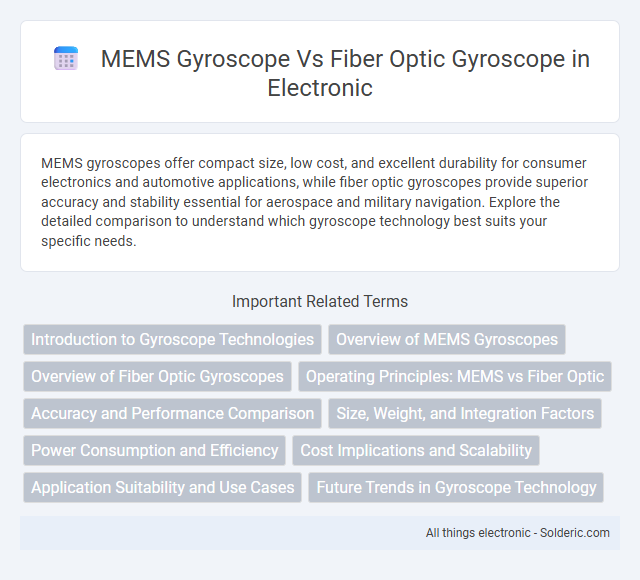MEMS gyroscopes offer compact size, low cost, and excellent durability for consumer electronics and automotive applications, while fiber optic gyroscopes provide superior accuracy and stability essential for aerospace and military navigation. Explore the detailed comparison to understand which gyroscope technology best suits your specific needs.
Comparison Table
| Feature | MEMS Gyroscope | Fiber Optic Gyroscope (FOG) |
|---|---|---|
| Technology | Microelectromechanical systems, vibrating structure | Interference of light in fiber optic coil |
| Accuracy | Low to moderate (+-0.1 to +-1 deg/s) | High accuracy (+-0.001 deg/s or better) |
| Size | Very small, compact (mm scale) | Relatively larger due to fiber coil |
| Cost | Low cost, mass-producible | High cost due to complex components |
| Durability | Robust, resistant to shock and vibration | Sensitive to mechanical stress, requires careful handling |
| Power Consumption | Low power consumption | Moderate to high power consumption |
| Applications | Consumer electronics, drones, automotive stability | Inertial navigation, aerospace, submarines |
| Drift | Higher drift, requires frequent calibration | Minimal drift, highly stable |
Introduction to Gyroscope Technologies
MEMS gyroscopes utilize microelectromechanical systems to detect angular velocity through vibrating structures, offering compact size, low cost, and suitability for consumer electronics and automotive applications. Fiber optic gyroscopes (FOGs) rely on the Sagnac effect using coherent light traveling through optical fibers, delivering high precision and resilience in navigation systems for aerospace and defense. The contrasting principles and performance metrics between MEMS and fiber optic gyroscopes define their respective advantages in accuracy, scalability, and environmental robustness.
Overview of MEMS Gyroscopes
MEMS gyroscopes use micro-electromechanical systems to detect angular velocity through the Coriolis effect, making them compact and cost-effective for consumer electronics and automotive applications. These sensors offer high sensitivity and robust performance in small form factors, suitable for smartphones, drones, and wearable devices. Your choice of a MEMS gyroscope ensures efficient motion sensing with low power consumption and scalability for various embedded system integrations.
Overview of Fiber Optic Gyroscopes
Fiber Optic Gyroscopes (FOGs) utilize the interference of light traveling through coiled optical fibers to detect rotational movement with high precision and reliability, making them ideal for navigation systems in aerospace and defense. Unlike MEMS gyroscopes, which rely on vibrating mechanical structures, FOGs provide superior sensitivity, long-term stability, and resistance to electromagnetic interference. Your choice of gyroscope technology will depend on required accuracy, size constraints, and environmental factors, with FOGs excelling in applications demanding robust performance over extended periods.
Operating Principles: MEMS vs Fiber Optic
MEMS gyroscopes operate based on vibrating microstructures that detect angular velocity through Coriolis forces, providing compact and cost-effective inertial sensing. Fiber optic gyroscopes use the interference of light traveling through coiled optical fibers to measure rotation with high precision and excellent resistance to electromagnetic interference. Your choice between these technologies depends on the required sensitivity, size constraints, and application environment.
Accuracy and Performance Comparison
MEMS gyroscopes offer compact size and low cost but generally have lower accuracy and higher drift rates compared to fiber optic gyroscopes (FOGs), which provide superior sensitivity and precision due to their reliance on the Sagnac effect. FOGs excel in high-precision navigation and aerospace applications with minimal signal noise and bias instability, while MEMS gyroscopes are better suited for consumer electronics and automotive systems where size and power consumption are critical. The performance gap is evident in FOGs achieving bias stability as low as 0.001deg/hr, whereas MEMS devices typically range around 1deg/hr or higher.
Size, Weight, and Integration Factors
MEMS gyroscopes are significantly smaller and lighter, often measuring just a few millimeters and weighing a few grams, making them ideal for compact and portable applications. Fiber optic gyroscopes (FOGs), while larger and heavier due to their coiled fiber and optical components, provide higher precision but face integration challenges in limited space environments. MEMS technology excels in ease of integration with microelectronic systems, whereas FOGs require more complex packaging and power considerations, impacting their deployment in size- and weight-sensitive platforms.
Power Consumption and Efficiency
MEMS gyroscopes consume significantly less power, typically in the range of milliwatts, making them highly efficient for battery-operated devices and wearable technology. Fiber optic gyroscopes, while offering superior precision and stability, require higher power inputs due to their laser and optical components, often consuming watts of power. Your choice depends on balancing power efficiency with accuracy needs, where MEMS gyroscopes excel in low-power applications and fiber optic gyroscopes dominate in high-precision navigation systems.
Cost Implications and Scalability
MEMS gyroscopes offer significant cost advantages due to their low manufacturing expenses and compatibility with mass production, making them ideal for consumer electronics and automotive applications. Fiber optic gyroscopes, while more expensive because of intricate materials and complex assembly processes, provide higher precision suitable for aerospace and defense sectors. Scalability favors MEMS technology as it leverages semiconductor fabrication techniques, enabling large-scale deployment with consistent performance and reduced unit costs.
Application Suitability and Use Cases
MEMS gyroscopes excel in consumer electronics, automotive stability control, and drone navigation due to their compact size, low cost, and durability in dynamic environments. Fiber optic gyroscopes are preferred in aerospace, marine navigation, and precision robotics, where superior accuracy, drift resistance, and long-term stability are critical. The choice between MEMS and fiber optic gyroscopes depends on balancing precision requirements against budget and size constraints for specific applications.
Future Trends in Gyroscope Technology
MEMS gyroscopes are rapidly advancing with improved sensitivity and miniaturization driven by innovations in microfabrication and integration with AI for real-time data processing. Fiber optic gyroscopes continue to evolve with enhanced precision and robustness, leveraging developments in photonic integration and advanced signal processing to meet demands in aerospace and autonomous navigation. Your choice between these technologies will depend on future applications requiring a balance of cost, durability, and accuracy.
MEMS gyroscope vs fiber optic gyroscope Infographic

 solderic.com
solderic.com